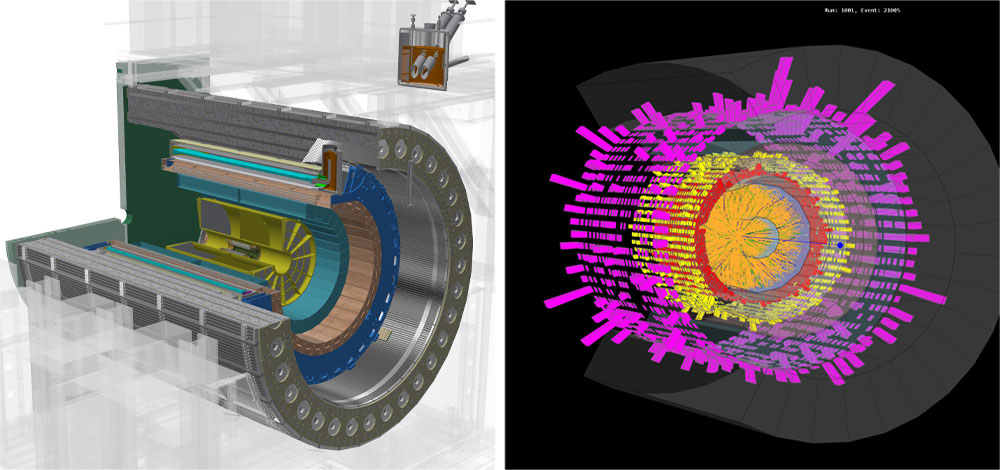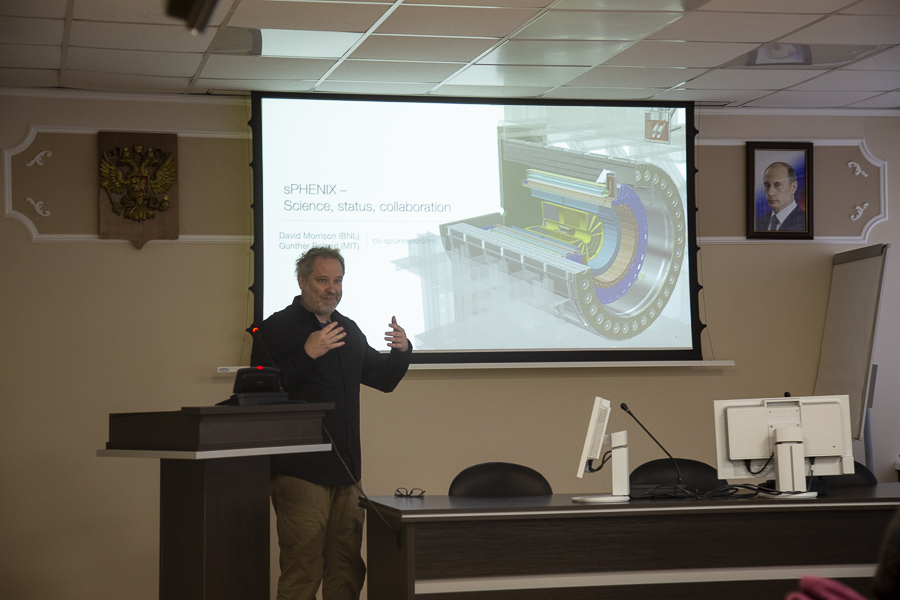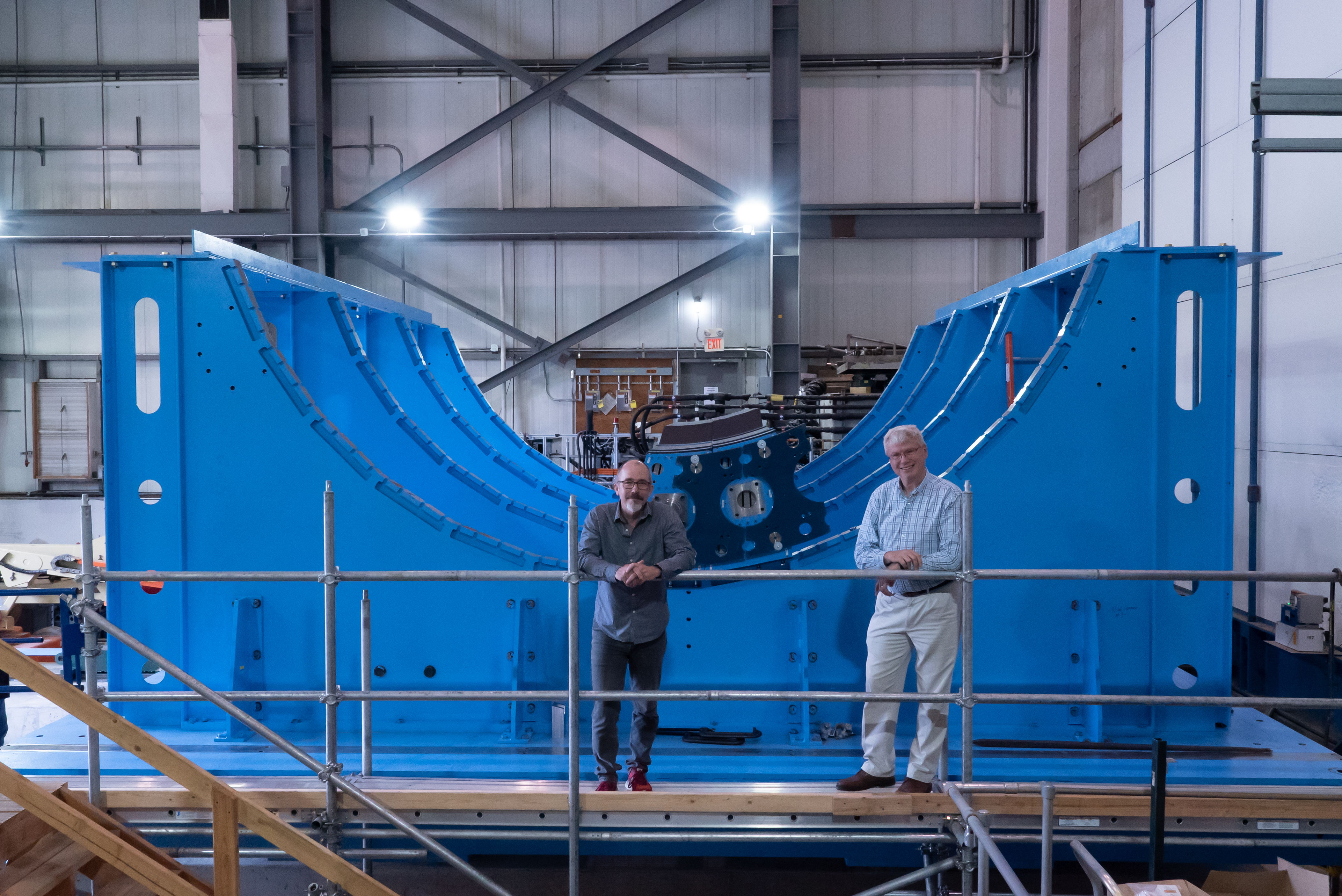Brand new, state-of-the-art components for an upgraded 1000-ton particle detector are being installed at the U.S. Department of Energy’s (DOE) Brookhaven National Laboratory. Known as sPHENIX, the detector is a radical makeover of the PHENIX experiment, which first began taking data at the Lab’s Relativistic Heavy Ion Collider (RHIC) in 2000. The sPHENIX upgrade will significantly enhance scientists’ ability to learn about quark-gluon plasma (QGP), an exotic form of nuclear matter created in RHIC’s energetic particle smashups.

Left: A schematic of the components of the sPHENIX detector, an upgrade to the PHENIX experiment at the Relativistic Heavy Ion Collider (RHIC), currently underway at Brookhaven National Laboratory. When complete, the detector will capture snapshots of 15,000 particle collisions per second, like the simulated event shown here (right).
What is Quark-Gluon Plasma?
QGP is a soup of subatomic particles called quarks and gluons. These particles ordinarily exist only as parts of other particles, including the protons and neutrons that make up the nuclei of atoms in today’s world. But for a brief instant billions of years ago, before protons and neutrons formed, the whole universe was made of free, unbound quarks and gluons. Smashing the nuclei of heavy atoms together at very high energies turns back the clock. The collisions “melt” the protons and neutrons, setting free their inner building blocks. By tracking the particles that emerge from this quark-gluon soup, scientists get clues about how the universe evolved. They also learn about the force that holds these fundamental building blocks together.

“RHIC has made many discoveries about the properties of QGP,” said Gunther Roland, co-spokesperson for sPHENIX and a physicist at the Massachusetts Institute of Technology. “Now, we need a new microscope to look at the structure of QGP in more detail and with higher precision. That microscope is sPHENIX.”
sPHENIX, a project of the DOE Office of Science’s Office of Nuclear Physics, will start collecting data in 2023. When the construction is complete, the detector will be about the size of a two-story house, cylindrical in shape with an enormous superconducting magnet at its core. The magnet will bend the trajectories of charged particles produced in the collisions, while different detector components layered within and around the central core measure the energy and other properties of particles emitted from each collision. Like a giant, 3D digital camera, the detector will capture snapshots of 15,000 particle collisions per second, more than three times faster than PHENIX.
“sPHENIX was designed specifically to take advantage of all of the accelerator improvements made to increase collision rates at RHIC over the last 20 years,” said Ed O’Brien, the sPHENIX project director.
A team of dedicated scientists, engineers, technicians, and students has been working to build and test components for sPHENIX both at Brookhaven and at universities and collaborating institutions across the country and around the globe. They’ve designed and optimized each component, building on experience gained at RHIC and at Europe’s Large Hadron Collider (LHC). The LHC spends a portion of its time creating QGP at higher energies than at RHIC.
“Detector and analysis techniques developed at the LHC are amazing,” said Brookhaven Lab nuclear physicist Dave Morrison, the other sPHENIX co-spokesperson. “sPHENIX is bringing those techniques back to RHIC. Everything we’re doing now has benefitted from every single bit of R&D to make sPHENIX the best it can be and easy to assemble. We’ve moved from having architects discuss the plans for the ‘house’ to general contractors actually hammering together the two-by-fours.”
Assembling detector sectors
sPHENIX nuclear physicists have been working with an international team of engineers, technicians, and others to assemble detector components. The team includes a dozen graduate students who traveled to the Lab from various collaborating institutions to perform mission-critical work on the sPHENIX upgrade during the COVID-19 pandemic.
“There is tremendous value in junior people being involved at an early stage of the experiment they will ultimately take data with,” said Dennis Perepelitsa, an sPHENIX collaborator and physics professor at the University of Colorado Boulder (CU). “There’s nothing like having that physical ‘ hands-on’ connection between the data you’re trying to understand and the detector that actually recorded it.”
Four CU graduate students helped assemble components and test two of the major calorimeters—detector systems that measure the energy of different types of charged and uncharged particles emerging from RHIC’s collisions of ions.
Each calorimeter is made of many separate sectors that pick up signals from particles emerging in all directions from the hot soup of quarks and gluons created in the smashups. These measurements will help scientists study how jets of particles generated by collisions with individual quarks or gluons are affected by the hot, dense soup of the quark-gluon plasma. The findings should help them understand how the properties of QGP arise from these underlying quark-and-gluon interactions.
“I was set up to work on some initial testing of electronic components for the electromagnetic calorimeter—before they were incorporated into the calorimeter sectors—and final electronics readout testing of the finished sectors,” said Jeff Ouellette, a fifth-year Ph.D. candidate from CU, who arrived at Brookhaven in November 2020. He also helped to finish the “outer hadronic calorimeter”—made of similar detector components that will surround the solenoid magnet and measure the energy of hadrons, which are particles made of quarks.
“Fundamentally, the design is very similar. So, it was easy to learn something while working on one detector and apply it to the other,” he said.
sPHENIX’s 70-ton carriage base arrived at Brookhaven Lab in May. Riggers, technicians, and engineers maneuvered it into place on the newly reinforced assembly platform. Tracks will allow the detector to slide into the interaction region when complete. Hover over image to reveal slideshow controls.
Berenice Garcia, a third-year Ph.D. student from CU, joined the team at Brookhaven in January 2021.
“Jeff Ouellette and Stefan Bathe, the scientist managing the outer hadronic calorimeter, walked us through how to assemble a sector and test it,” she said. “It was sort of like following a cooking recipe. They provided all the ingredients—tiles, signal cables, optical fibers, etc.—and we had to put them together by following a series of steps.
“The challenge came when we had to test the sector and make sure we were getting the expected signals,” she noted. “There were times when we would not get a signal at all, so we had to figure out what part was causing this issue. Sometimes it would take minutes, but there were plenty of times where it would take hours! But that’s OK because it made us that much happier when we finally found the solution to our problem!”
Putting together the building blocks
When the calorimeter sectors were fully assembled and tested, it was time to start putting the detector building blocks together so they’ll be ready to start unraveling the secrets of the building blocks of matter.
In May, the detector’s 70-ton carriage base—built at a steel machining shop in upstate New York—arrived on site at Brookhaven. This base provides the foundation for assembling the detector components from the bottom up.
First come the lower sectors of the hadronic calorimeter, forming an outer ring around the cylindrical superconducting solenoid magnet.
“There are 32 sectors in all, each about 20 feet long and weighing up to 18 tons,” Morrison said. “We’ll install the ones at the bottom one sector at a time. When it gets up to the half-way point, then the solenoid magnet will get placed on top, and then the rest of the calorimeter segments will get placed around and above the magnet—kind of like you’re building a Roman arch.”
The scientists will add silicon detectors and a Time Projection Chamber for tracking and determining the momentum of all charged particles.
“There has been an enormous amount of progress,” Morrison said. “We’re about halfway through the construction phase and less than two years from when we’ll begin taking data.” In the world of putting together an enormous physics detector, he said, “That’s practically tomorrow!”
Infrastructure modernization
In addition to upgrading the detector itself, the RHIC team has also made many improvements to the PHENIX experimental hall and support buildings. These infrastructure improvements will help sPHENIX operate as efficiently as possible.
“sPHENIX includes the latest innovations in modern, large scale, multipurpose collider detectors,” said Maria Chamizo-Llatas, Deputy Associate Laboratory Director for Strategic Planning of Future Research Programs in the Nuclear and Particle Physics Directorate at Brookhaven Lab. “Modernizing the facility is crucial to hosting such a state-of-the-art 21st century detector.”
For example, the superconducting magnet at the core of sPHENIX must be super cold—kept near zero temperature—to carry electric current with zero resistance. That superconductivity is the feature that allows the magnet to carry high electric currents to generate very powerful magnetic fields. Such strong fields can bend the trajectories of even high-velocity charged particles like electrons and positrons.
“The strong bending power will give us the ability to study electrons and positrons that result from the decay of other particles called upsilons,” said experiment co-spokesperson Roland. Upsilons come in three varieties with minutely small differences in mass. The strong magnetic field will allow physicists to precisely tease out the trajectories of the decay products and calculate the mass of the “parent” upsilon to distinguish among the different varieties. “This ability to cleanly separate particles with tiny differences in mass will be a defining characteristic of sPHENIX,” Roland said.

sPHENIX co-spokesperson David Morrison and sPHENIX project director Edward O’Brien stand next to the curved structure that will support the detector. Between them you can see the first two sectors of the outer hadronic calorimeter in place.
To keep the magnet cold, Brookhaven’s Collider-Accelerator Department engineers and technicians will connect it directly into the cryogenic system that supplies liquid helium at a temperature of -452 degrees Fahrenheit to RHIC’s superconducting accelerator magnets. “This setup provides an efficient and cost-effective liquid helium source for the magnet,” said sPHENIX project engineer James Mills.
The upgraded detector will also require additional structural support in the assembly hall and in the interaction within the RHIC ring where it will sit when taking data.
“The overall weight of sPHENIX is not much different than the original PHENIX experiment, but sPHENIX is more compact,” said Russell Feder, the project’s chief mechanical engineer. “This smaller footprint creates more localized forces on the floor and soil substructure below it.”
To handle the load, the team is installing additional steel reinforcement embedded in a concrete matrix. “This system will be structurally connected to the existing track system that supports the detector and allows it to be moved from the assembly area into the interaction region,” Feder said.
“We couldn’t have done this upgrade without the support from key Brookhaven Lab organizations and the dedicated technical and engineering staff,” Chamizo-Llatas said.
“It has been an incredible team effort to get us to this point,” agreed sPHENIX project director O’Brien. “We are getting critical contributions not only from our dozens of collaborating institutions, but also vital support from many Brookhaven Lab organizations and the U.S. Department of Energy. Without the close cooperation of everyone it would have not been possible to build a major scientific instrument during a global pandemic.”
RHIC is a DOE Office of Science User Facility.
The transformation of PHENIX to sPHENIX and operations at RHIC is funded by the DOE Office of Science.
